Company: The Coca-Cola Company
CEO: James Quincey
Year founded: 1886
Headquarter: Atlanta, USA
Number of Employees (Dec 2023): 79,100
Public or Private: Public
Ticker Symbol: NYSE: KO
Market Cap (Jul 2024): $274.42 Billion
Annual Revenue (Dec 2023): $45.7 Billion
Profit |Net income (Dec 2023): $10.7 Billion
Products & Services: Coca-Cola | Diet Coke | Coke Zero | Ciel | Barq’s | Dasani | Del Valle | Fanta | Fair life | Fresca | Georgia | Gold Peak Tea | Minute Maid | Peace Tea | Powerade | Simply Beverages | Glaceau Smartwater | Sprite | Suge | Glaceau vitamin water
Competitors: Pepsi | Dr Pepper Snapple | Mountain Dew | Gatorade | Nestle | Redbull | Unilever | Heineken | Diageo |
Fun Fact:
Did you know that 2.2 billion servings of Coca-Cola beverages are consumed worldwide every day?
Did you know that Coca-Cola originally contained traces of Cocaine?
An Overview of Coca-Cola
The market leader in the soft drinks industry, Coca-Cola, is one of the most recognized brands worldwide. Be it your home, office, shops, hotels, bars, or restaurants, Coca-Cola is everywhere!
94% of the world’s population recognizes the brand instantly by its red and white Coca-Cola logo. Coca-Cola says more than 2.2 billion servings of their many products are consumed in 200 countries every day.
Coca-Cola was established in 1886 in Atlanta by John Pemberton. Within a few years, Coca-Cola became the most recognized, renowned, and widely distributed brand in the world.
When it was introduced, Coca-Cola contained small amounts of cocaine from coca leaves and caffeine from kola nuts. These two ingredients gave the product its unique name.
In addition to Coca-Cola and other carbonated beverages, the company also makes and sells juices and other non-carbonated beverages and has moved into alcoholic beverages with the introduction of hard seltzers.
Currently, James Quincey is the CEO of this mega-corporation.
Read on to discover more about the world’s renowned beverage brand through this Coca-Cola SWOT analysis.
SWOT Analysis of Coca-Cola
Coca-Cola Strengths – Internal Strategic Factors
1. Strong Brand Identity
Coca-Cola is a highly popular brand with a unique brand identity that gives it a significant competitive advantage.
With its contouring and curves, the iconic Coca-Cola bottle shape is instantly recognizable. It was originally designed in 1915. The font, also highly identifiable and associated with Coca-Cola, is Spencerian Script, which has been around since about 1850. The Coca-Cola logo, with a simple red and white color scheme, is also instantly recognizable and hasn’t changed much since it was created in 1887.
2. High Brand Valuation
Coca-Cola is undoubtedly one of the most renowned brands and has a high brand value. According to Interbrand’s 2023 annual report, Coca-Cola is ranked 8th best global brand, with a brand value of $58 Billion. Other top-ranking companies on the list are Apple at #1, Microsoft at #2, Amazon at #3, Google at #4 and Samsung at #5 position. [1]
3. Extended Global Reach
Coke is sold almost everywhere. It is available in nearly 200 countries, with sales of 2.2 billion servings per day of company products. It has introduced more than 500 new products globally.
Some of these have been variations of Coca-Cola beverages, like Coca Cola Vanilla and Cherry Coca-Cola, while others are quite different, including other carbonated beverages like Sprite and non-carbonated offerings, including juices, and iced tea and coffee. Its brands are known to touch every lifestyle and demographic.
4. Greatest Brand Association and Customer Loyalty
Coca-Cola is considered one of the US’s most emotionally-connected brands. This valuable brand is known for advertising campaigns that feature happiness and joy, and has strong customer loyalty. Customers can quickly identify their particular taste, and finding substitutes is difficult for them. Moreover, Coca-Cola and Fanta have a huge fan following – larger than other beverage names in the industry.
5. Dominant Market Share
By far the two largest manufacturers of soft drinks in the beverage segment are the Coca-Cola Company and Pepsico. Coca-Cola has the largest market share, although Pepsi is not far behind. Coke, Sprite, Diet Coke, Fanta, Limca, and Maaza are high-growth drivers for Coca-Cola.
6. Extensive Distribution system
Coca-Cola has an extensive and efficient distribution network. The company has about 200 bottling partners and about 950 production facilities globally. It operates in nearly every Country in the world.
7. Acquisitions
Coca-Cola has a long list of strategic and profitable acquisitions, including the Costa coffee chain, Fairlife (Milk Products), Fuze Tea, AdeS, and many more. Through these acquisitions, Coca-Cola expanded its ready-to-drink beverage portfolio.
8. Repositioning Portfolio
The Coca-Cola Company has repositioned and reduced the number of its global brands from 400 to 200 brands into five major categories such as:
- Coca Cola
- Sparkling Flavors
- Hydration, Sports, Tea & Coffee
- Juice, Nutrition, Dairy & Plant
- Emerging

Image source: Coca-cola annual report
9. Strategic Partnerships
Coke’s visibility and brand power are strengthened by a number of partnerships and sponsorships. One of its most visible sponsorships is its partnership with the Olympic Games. Coke has been a sponsor of every Olympics since 1928 and also sponsors the Paralympic Games.
Coca-Cola also supports local sports events and organizations at different levels in many parts of the world, including Nascar, the NCAA, and FIFA.
10. Expansion Through Acquisition
Coca-Cola’s growth has been helped by some of its recent acquisitions like Costa Coffee and Aha sparkling water.
The company can continue to acquire strategic businesses as it has the financial resources to acquire startups or SMBs in emerging markets and exploit the numerous opportunities they represent.
11. Capitalizing on Huge Social Media Potential
Social media outlets have massive reach, and Coca-Cola has begun to tap into this potential. Increased social media collaborations and initiatives have the potential to reach billions of consumers.
TikTok for example is a huge platform with over 1 billion monthly active users. Coca-Cola entered the TikTok stratosphere when it announced the company’s first-ever TikTok challenge in the US. It’s an excellent move for the company to enhance its brand recognition further.
In the TikTok challenge, Coca-Cola collaborated with Grammy-nominated music artist ‘Khalid’ to sing the challenge’s first opening song and choreographer Jalaiah Harmon, the young woman behind the famous Renegade Dance.
12. Partnerships with Alcohol Brands
Coke is already a well-known mix for alcoholic beverages, and there is a significant opportunity to leverage this fact. The global ready-to-drink spirits-based cocktail drink market was valued at $853.2 billion in 2022 and is anticipated to grow at an impressive 14% CAGR between 2023 and 2030.
Coke recently teamed up with Constellation Brands to make alcoholic Fresca cocktails. It seems like a good maneuver by Coca-Cola in an ecosystem where a handful of non-alcoholic brands are diversifying their product portfolios. Increased moves in this area represent significant opportunities for sales.
Coca-Cola Weaknesses – Internal Strategic Factors
1. Product Diversification
Coca-Cola has low product diversification. While it has introduced new products, not all of them have been successful. When products fail to resonate with customers, it impacts the company’s growth strategy.
2. Overdependence on Third-Party Technology Providers
Coca-Cola’s operations rely heavily on the technological expertise of third parties. The company signed another five-year deal with Microsoft to supply business software.
3. Cherished Coke Products Discontinued
James Quincy, the current CEO of Coca-Cola and a renowned businessman, was bombarded by messages from disgruntled Coke fans.
The complaints stemmed from the CEO’s shocking decision to permanently discontinue some of the most popular products from Coca-Cola’s diverse product portfolio. Coca-Cola eliminated in-demand and popular products such as Tab (a diet drink), Odwalla (a smoothie brand), and the beloved coconut water Zico.
4. Dependence on US Market for Soft Drinks
Despite some product diversification, a big chunk of the company’s revenue still comes from soft drinks. By far the biggest market for soft drinks is the US. Any disruption in that market could have negative consequences for Coca-Cola.
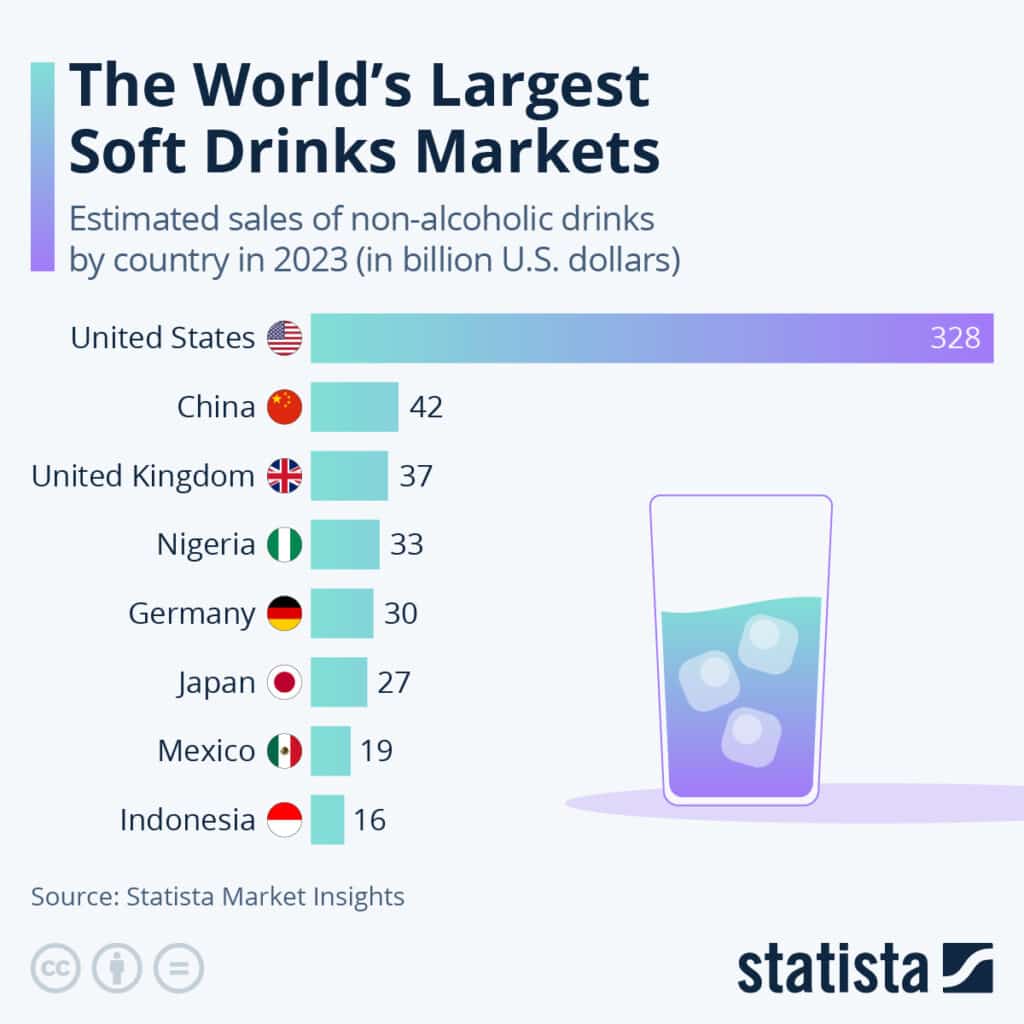
Source: Statista
Coca-Cola Opportunities – External Strategic Factors
1. Consumers Prefer Healthier Options
The health and wellness food market in the US alone is anticipated to reach $1.48 billion by 2027. In the forecast period (2021 to 2027) that’s a CAGR of 7.23%.
Coca-Cola has the opportunity to introduce new offerings in the healthy drinks and food segments, just like Pepsi. This can contribute to the company’s revenue and brand image and allow it to branch out from carbonated drinks and salty snacks to healthier options.
2. Emerging Markets
Emerging markets represent some of the largest opportunities for growth in cold beverage sales. For example, Africa is projected to be the fastest-growing market for carbonated soft drinks, according to Mordor Intelligence. The predicted CAGR between 2024 and 2030 is 8.12%, compared to 4.73% globally.
An increased presence and expansion of product offerings in such emerging markets can be an excellent source of growth for the company.
3. Consumers Demanding Packaged Water
Coca-Cola should further expand into the growing market for packaged drinking water. The global packaged water market was valued at $333.2 billion in 2023 and is projected to reach $538.9 billion by 2032 – an impressive 5.67% CAGR.
Coca-Cola owns some drinking water brands like Dasani and Kinley, but Coca-Cola has great potential for expansion in this segment.
Coca-Cola Threats – External Strategic Factors
1. Lawsuits
Trust is undermined, and reputation is damaged whenever the company is accused of wrongdoing.
Coca-Cola, not unlike other large companies, has faced a number of lawsuits for a variety of reasons. Among them:
- As owner of Simply Orange, Coca-Cola has been named in a lawsuit claiming the product contains hazardous compounds.
- Another lawsuit alleges Coca-Cola’s marketing of margarita-flavored hard seltzers implies the beverage contains tequila when it does not.
- Coca-Cola is facing a patent infringement lawsuit for using a dispenser that can recognize users and customize drinks based on their preferences.
In order to limit the potential damage lawsuits would do to Coca-Cola, it’s imperative they continue to manage each one closely and to get ahead of them publically whenever necessary.
2. Water Usage Controversy & Other Environmental Concerns
Coca-Cola has faced many criticisms over water management issues. Many social and environmental groups have claimed that the company consumes vast amounts of water in water-scarce regions. Besides that, people have alleged that Coca-Cola is polluting water and mixing pesticides in water to clear contaminants.
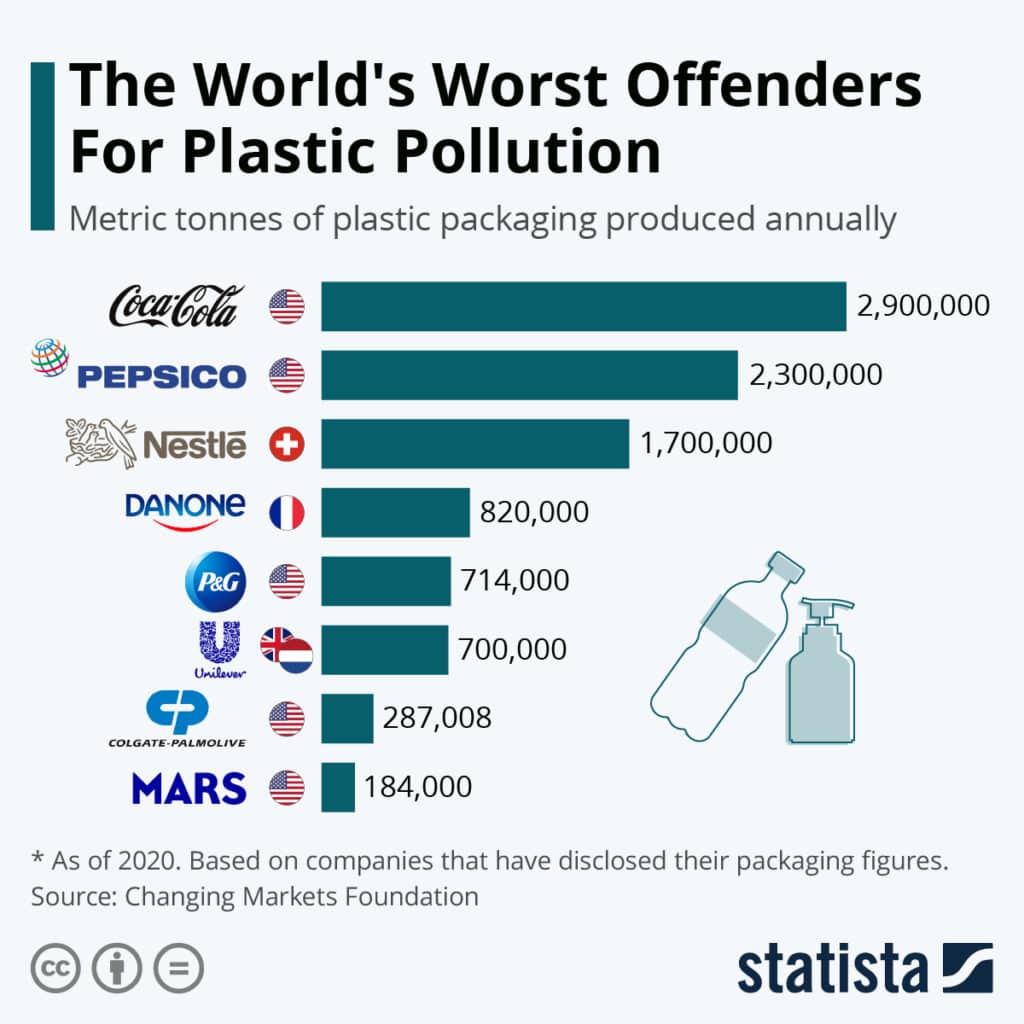
Source: Statista
3. Direct and Indirect Competition
Coca-Cola faces ongoing intense competition from PepsiCo, and some analysts feel Pepsi has a chance to out-grow Coca-Cola. They point not to increased sales of carbonated beverages but to PepsiCo’s broad and expanding line of snacks.
Among the popular snacks contributing to Pepsi’s growth are Lay’s Potato Chips, Ruffles, Sun Chips, Doritos, and Cheetos.
Although direct competition from Pepsi is clear in the market, there are many other companies which are indirectly competing with Coca-Cola. Starbucks, Tropicana, Lipton juices, and Nescafe, are the indirect competitors of Coca-Cola, which can threaten its market position.
4. Economic Uncertainty
Recent global events negatively affected business operations supply and distribution chains, and devastated revenues of many global companies. In 2020, Coca-Cola’s revenues declined drastically as restaurants, theaters, and other venues that contribute about half of its revenue remained closed due to the global crisis. Although there has been a recovery, economic conditions remain variable.
5. Increasing Health-Consciousness
Consumers are increasingly adopting healthy lifestyles and avoiding products with unhealthy ingredients.
The increase in health consciousness can reduce Coca-Cola’s sales and profits as customers migrate to healthier options offered by competitors.
6. Coca-Cola Recalls
In December of 2023, Coca-Cola recalled thousands of cans of Diet Coke, Sprite, and Fanta. The cans were sold in parts of the Southern US, and the company said the cans could contain ‘foreign material.’
In 2024, the company had to take some Powerade variety packs off the shelves over concerns they may contain a ‘foreign metal object’, in particular a stainless steel ring.
Earlier, According to Food Safety News, Coca-Cola announced a recall of its Minute Maid and Coke products over possible contamination issues. According to reports, the brands that were recalled included Minute Maid Berry Punch, Strawberry Lemonade, and Fruit Punch.
The products were found to contain metal bolts and washers. The company recalled all 59-oz cartons that were distributed. Moreover, Coca-Cola also recalled 12-oz coke cans over possible “foreign contaminants.”
Continued recalls could have a devastating impact on sales if consumers no longer trust the quality of Coca-Cola products.
7. Health Concerns
Carbonated drinks are one of the major sources of sugar intake. It results in two grave health issues – obesity and diabetes. Coca-Cola is the biggest manufacturer of carbonated beverages in the world.
Many health experts have prohibited the use of these soft drinks. It is a controversial issue for the company and one that does not have a quick or easy solution. The introduction of sugar substitutes to reduce sugar content in products has its own controversies, with some studies linking artificial sweeteners to many health hazards. However, Coca-Cola hasn’t devised any health alternative or solution for this problem yet.
8. Environmentally Destructive Packaging
In the 2020 Tearfund report, Coca-Cola was named one of the four world’s largest consumer brands that are contributing immensely to global warming and carbon emissions by using throwaway plastic bottles. [5]
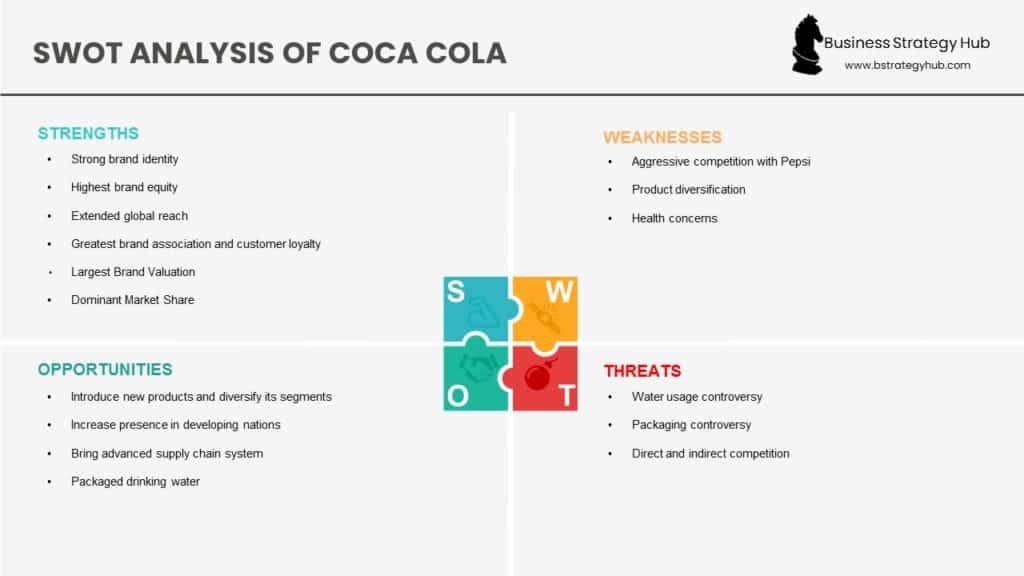
SWOT Analysis of Coca-Cola
Recommendations
Based on the above SWOT analysis of Coca-Cola, we can conclude that Coca-Cola has a leading market position in the soda industry. However, it is recommended the company make more innovative changes.
Some recommendations are explained as follows:
- Stepping into the food market – Coca-Cola needs to introduce new products in snacks and food segments of the market in order to compete with Pepsi’s strength in this area
- Focusing on health-related matters – Coca-Cola should find solutions to address the rising health concerns from social activists about sugar content and other issues.
- It should improve its water management system and deal with criticisms from environmental agencies concerning water use and quality.
- Expanding into developing countries with hot temperatures – There are many Coca-Cola products like Fuze Tea, Dasani, and Hi-C, which aren’t distributed in many developing countries. Coca-Cola needs to increase the distribution of such products in new and unsaturated markets.
- Increasing the distribution of packaged drinking water like Kinley.
- Working on sustainability and green marketing can improve Coca-Cola’s brand image in the market.
References & more information
- Interbrand Ranking 2023. Best Global Brands: Coca-Cola. Interbrand
- Johnston, M. (2020, June 1). 5 Companies Owned by Coca-Cola. Investopedia
- Law360 (2020, April 6). Fed. Circ. Weighs Undoing Coca-Cola Soda Dispenser IP Win. Law360
- Nellis, S. (2020, April 27). Microsoft wins a five-year deal with Coca-Cola to supply business software. Reuters
- Win, L. T. (2020, March 31). Bottling it? Plastic pollution from Coca-Cola PepsiCo fuels emissions. Reuters
- Scully, J. (2020, January 31). Coca-Cola’s growth in 2019 was driven by trademark Coke beverages. Food and Beverages
- McCormick, E. (2020, February 27). Coke and Pepsi sued for creating a plastic pollution ‘nuisance.’ The Guardian
- Balu, N. (2020, April 21). Coronavirus lockdowns to hurt Coca-Cola’s second-quarter sales. Reuters
- Askew, K. (2020, January 15). Shifting Away from Sugar: What’s the outlook in 2020? Food Navigator
- Coca-Cola Company (retrieved 204) The Coca-Cola System
- NBC News (2023, December 13) Coca-Cola Contamination Recall
- Consumer Lab (2024, April 10) Powerade Recall
- Business Research Insights (2024, February) Health And Wellness Food Market Size, Share, Forecast To 2031(business research insights.com)
- Grandview Research (2024, May 17) Ready To Drink Cocktails Market Size & Share Report, 2030 (grandviewresearch.com)
- Mordor Intelligence (Retrieved July 2024) Carbonated Beverages Market
- Custom Market Insights (Retrieved July 2024) Bottled Water Market
Tell us what you think? Did you find this article interesting? Share your thoughts and experiences in the comments section below.

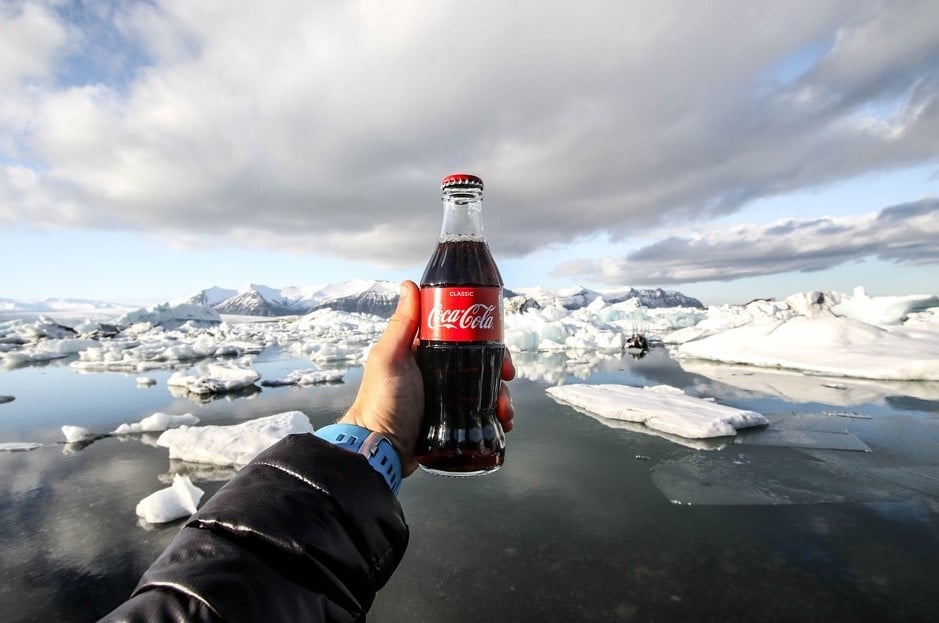

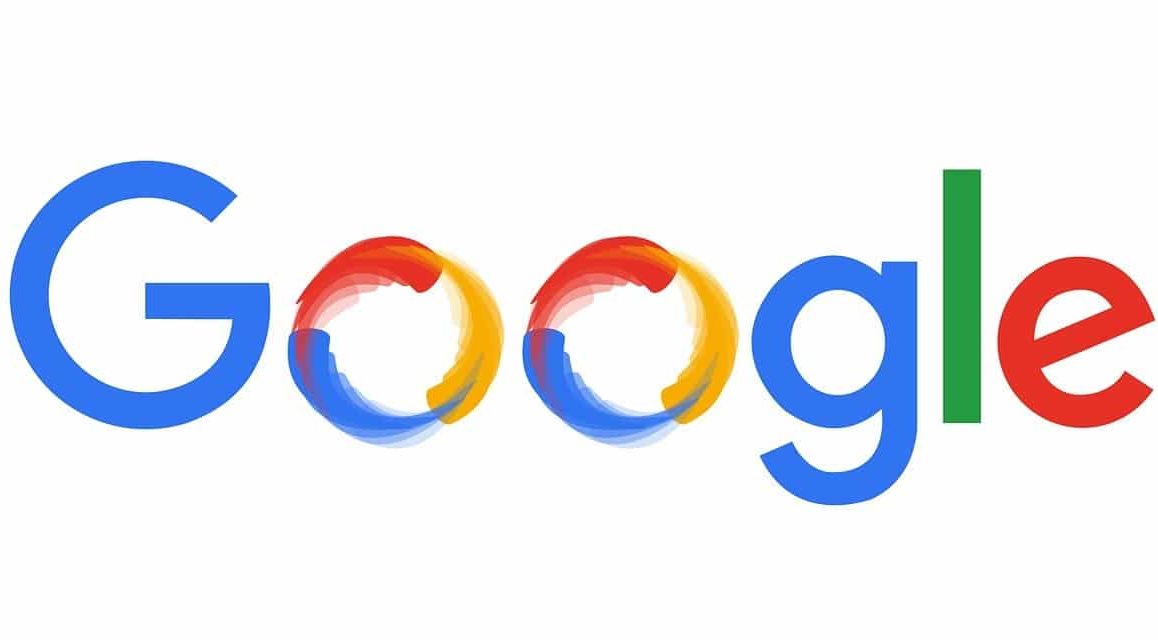







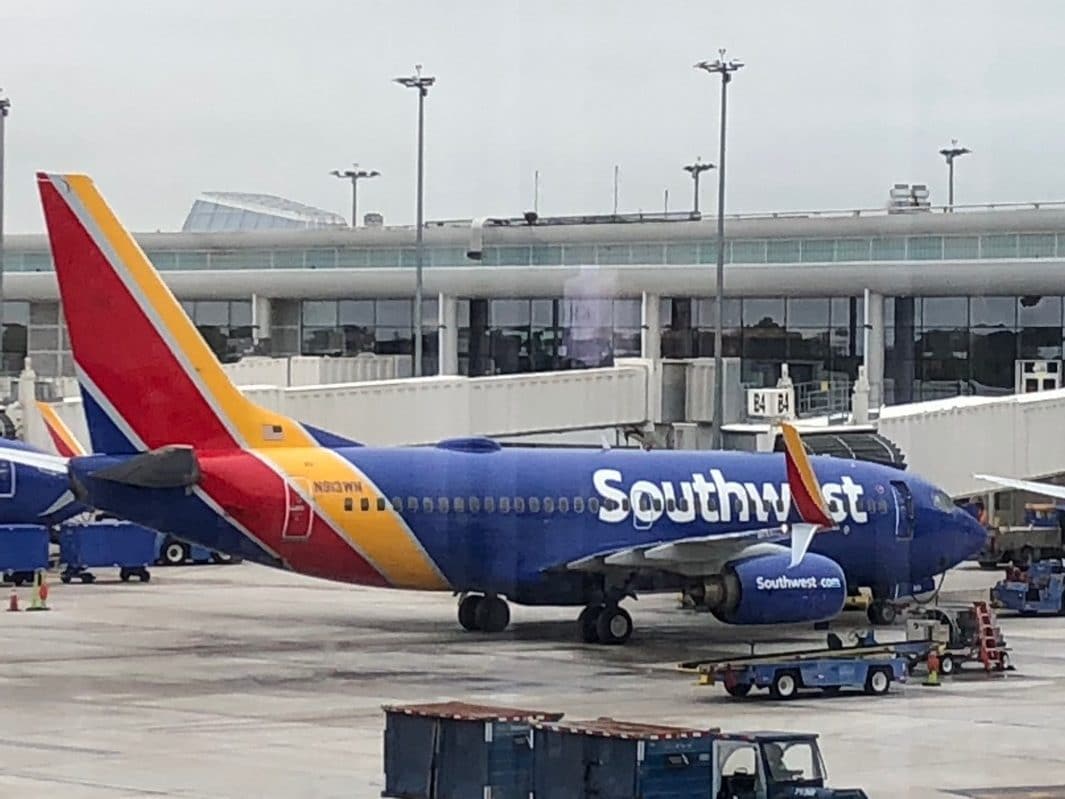
Hi i want to use your work as a example but i can not find the date and author or that work, could you help me please
Hi Maciek,
there you go…
Author name: Brianna Parker
Last updated: March 14, 2023
Thankyou so much Brianna you deserve the world